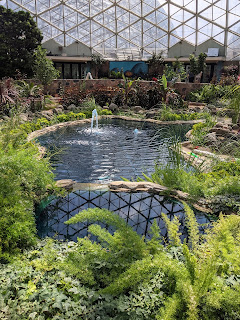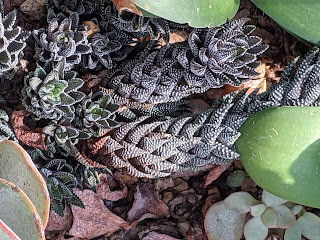Before heading to Chicago in June from Milwaukee, Wisconsin, we stopped at what was known officially as the Mitchell Park Horticultural Conservatory, but better known as The Domes for obvious reasons! It was home to living plants from all over the world. The Conservatory was composed of three beehive-shaped glass domes, also referred to as the world's first conoidal domes, and were constructed in stages from 1959 to 1967.
Walking into the Tropical Dome was a little like entering a steamy rainforest and being transported to another world with some 1,200 species of plants taking up every inch of the Dome.
The unusual Flamingo Flower was native to Colombia.
How little ones would love to see the Fairy Garden! One of the plants in the garden was an Earth Star - your guess is as good as mine as to which one it was!
I am almost always in the mood for chocolate and seeing this Chocolate Pudding Tree reminded me of that. The black sapole tree from southern Mexico and Central America bears a fruit that looks like a tomato and is high in Vitamin C. After the fruit ripens, the inside is dark brown, almost black, and is soft and sweet. When lemon or lime juice is added, the fruit can be used as pie filling.
As a child growing up in Canada, I remember so well chewing Chiclets, the tiny square-shaped pieces of white gum. One of the original Domes plantings from 1966 was the Chicle Tree popular with Indigenous peoples from Mexico to Costa Rica. After making zigzag gashes into the tree, they collected the dripping gum and mixed it with flavorings to chew. The Wrigley Company helped develop a similar product to make chewing gum which was marketed as chiclets.
We entered the Show Dome next where five times a year that was the place to be for themed floral displays of flowers. As we were there outside one of those windows, the dome was easily missable in my opinion.
Because of the pandemic, visitors were required to follow the woodchip path in one direction and also practice safe distancing.
The Show Dome was a little too rah rah for me promoting the city's parks, its lakes, etc.
This marvelous lion head and seven others watched over the park's Sunken Garden and Water Mirror from when it opened in 1904 until they were removed in 1966. There was no explanation given why the formal gardens and water mirror were demolished in 1994.
As we hadn't been very impressed with the Show Dome, we hoped the last dome, the Desert Dome, would shine.
Even though Steven and I have spent a lot of time in the deserts of the American Southwest, I hadn't known until our visit that there was often more biomass lying underneath the surface than above it. Geophytes, like this Climbing Onion, are plants that appear when water is plentiful. When there is no water, the plants spend time underground bulbs, tubers, or corms. When they get wet, they start to grow again to produce seeds for the next generation.
Dennis and Gail: I wonder if you will see some of the impossibly tiny Silver Teaspoons when you get to Madagascar. Make sure to let me know, ok?!
We learned there were many different ecosystems on the southern tip of Africa. On the western coast was the Namib Desert whose main source of water was fog from the ocean. A bizarre-looking relative of conifers was the welwitschia which makes its home in the Namib. To survive, a giant taproot essentially 'drills' for water deep underground.
More plants from Madagascar:
The Fan Aloe was from South Africa.
An unusual-to-us plant was the Desert Candle also from South Africa. I thought it was a cactus but learned it was in fact a Columnar Euphobia as virtually all cacti are only found in the Americas. The role of large succulents in African deserts is the same as cacti - to conserve water and protect the plant.
One of the oddest natural wonders we'd ever seen were these Living Stones. Just by looking, it was easy to see where these plants got their name: their coloring and shape help them look just like stones. This adaptation has saved them from being found and eaten. The windows or 'clear skin' found in patterns across the top of their leaves was another survival mechanism of living stones. Beneath the windows was a thick layer of the plant's water storage tissue that hits the cells only after sunlight passes through this watery core.
These tiny living stones were grown at the Domes from seeds planted in 2013. It has taken that long for the stones to grow to the present size.
According to a sign at the Domes, the Middle Eastern Date Palm has been called a Tree Life, a Game Changer, a plant that has changed human history. Frustratingly, however, there was no further indication or explanation for those radical descriptions.
One of my favorite memories from our time in Israel was visiting the home of people we had met a few weeks earlier in Bulgaria who later invited us to spend a day traveling with them and at their home. I can remember as if it were yesterday how moist and luscious the dates were that were picked off one of the date palms and which I popped into my mouth! Never since have I had a date that came anywhere close to those, including buying some from a date farm in Arizona this past January.
It was easy to see this Old Man Cactus got its name from the gray-white whiskers that covered the entire plant. Even though plants obtain their energy through sunlight, too much overheating causes cell damage. The old man's 'beard' shades it from intense sunlight and scorching temperatures from the plant's home in Mexico. A cacti-growing craze began in Europe after WW I after collectors saw the fuzzy appearance of this cactus.
I bet you figured I did really like the Desert Dome, right?!
Were Milwaukee's Mitchell Domes fabulous? I'd say no but they were definitely worth seeing and a feather in the cap for the city.
Next post: Photos of Chicago's Wicker Park neighborhood where our daughter and her family live.
Posted on August 16th, 2021, from Tallahassee in eastern Florida as Steven and I were forced to evacuate yesterday afternoon from Grayton Beach State Park on Floria's Panhandle for at least three days because of Tropical Storm Fred. We won't know for another couple of days whether the park will reopen and we can return to our 'happy place' for a few more precious days.















































Lovely.
ReplyDeleteLike that Steve fellow :)
Thanks for reading, Andrew. I much prefer the other 'Steve' fellow however!
DeleteWhile you suggest the Domes were not fabulous, your photos were !! Thanks for the tour of Milwaukee's botanical gardens. x o Lina
ReplyDeleteLina,
DeleteI did enjoy the Mitchell Domes; it was that, by comparison, I found the Show Dome to be lacking vis-a-vis the top-notch desert Dome.
XOXO,
Annie
Thanks for the tour. We will have to take you to Denver Botanic Gardens to see some of the same plants in the Conservatory. I love the domes. St Louis Botanical Garden has a lovely single dome with tropical plants and many acres of plants and trees. Janina
ReplyDeleteJanina,
DeleteWould be great to revisit the DBG with you both sometime! I agree the St. Louis Botanical Gardens are among the best in the country.